语言学教程6.3
- 格式:ppt
- 大小:1.01 MB
- 文档页数:22
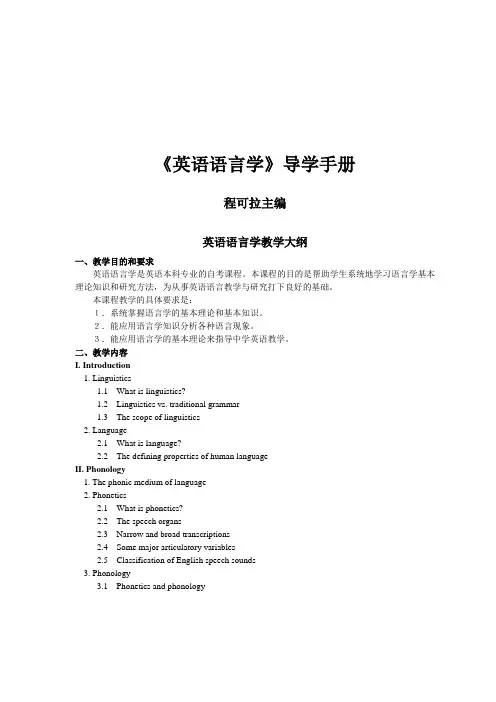
《英语语言学》导学手册程可拉主编英语语言学教学大纲一、教学目的和要求英语语言学是英语本科专业的自考课程。
本课程的目的是帮助学生系统地学习语言学基本理论知识和研究方法,为从事英语语言教学与研究打下良好的基础。
本课程教学的具体要求是:1.系统掌握语言学的基本理论和基本知识。
2.能应用语言学知识分析各种语言现象。
3.能应用语言学的基本理论来指导中学英语教学。
二、教学内容I. Introduction1. Linguistics1.1 What is linguistics?1.2 Linguistics vs. traditional grammar1.3 The scope of linguistics2. Language2.1 What is language?2.2 The defining properties of human languageII. Phonology1. The phonic medium of language2. Phonetics2.1 What is phonetics?2.2 The speech organs2.3 Narrow and broad transcriptions2.4 Some major articulatory variables2.5 Classification of English speech sounds3. Phonology3.1 Phonetics and phonology3.2 Phone, phoneme and allophone3.3 Phonemic contrast, complementary distribution, and minimal pair3.4 Some rules of phonology3.5 Suprasegmental features---Stress, tone, intonationIII. Morphology1. Morphology1.1 Open classes and closed classes1.2 Internal structure of words and rules for word formation2. Morphemes---the minimal units of meaning3. Derivational and inflectional morphemes4. Morphological rules of word formation5. CompoundsIV. Syntax1. Syntax1.1 What is syntax?1.2 Sentence2. Structuralist approach2.1 Form classes2.2 Constituent structure2.3 Immediate constituent analysis2.4 Endocentric and exocentric constructions2.5 Advantage of IC analysis2.6 Labelled tree diagram2.7 Discontinuous constituents3. Transformational-generative grammar3.1 Competence and performance3.2 Criteria for judging grammars3.3 Generative aspect3.4 Transformational aspect3.5 Deep and surface structures4. The Standard Theory4.1 Components of a TG4.2 The base4.3 Transformations4.4 The form of T-rules4.5 The phonological component4.6 The semantic componentV. Semantics1. Semantics1.1 What is semantics?2. Some views on semantics2.1 Naming things2.2 Concepts2.3 Context and behaviourism2.4 Mentalism3. Lexical meaning3.1 Sense and reference3.2 Synonymy3.3 Polysemy and homonymy3.4 Hyponymy3.5 Antonymy3.6 Relational opposites4. Componential analysis4.1 Componets of meaning4.2 Meaning relations in terms of componential analysis5. Sentence meaning5.1 How to define the meaning of a sentence?5.2 Selectional restrictions5.3 Basic statements about meaning6. The semantic structure of sentences6.1 Extended use of componential analysis6.2 Prediction analysis6.3 Subordinate and downgraded predictions6.4 Advantages of predication analysisVI. Pragmatics1. What does pragmatics study?2. Speech act theory3. Principles of conversation3.1 The co-operative principle3.2 The politeness principleVII. Language change1. Introduction2. Sound change3. Morphological and syntactic change3.1 Change in “agreement” rule3.2 Change in negation rule3.3 Process of simplification3.4 Loss of inflections4. V ocabulary change4.1 Addition of new words4.2 Loss of words4.3 Changes in the meaning of words5. Some recent trends5.1 Moving towards greater informality5.2 The influence of American English5.3 The influence of science and technology6. Causes of language changeVIII. Language and society1. The scope of sociolinguistics1.1 Indications of relatedness between language and society1.2 Sociolinguistics vs. traditional linguistic study1.3 Two approaches in sociolinguistics2. Varieties of language2.1 Varieties of language related to the user2.2 Standard dialect2.3 Varieties of language related to the use3. Communicative competence4. Pidgin and creole5. Bilingualism and diglossiaIX. Language and culture1. Introduction2. What is culture?3. Language and meaning4. Interdependence of language and culture5. The significance of cultural teaching and learning6. Linguistics evidence of cultural differences6.1 Greetings6.2 Thanks and compliments6.3 Terms of address6.4 Colour words6.5 Privacy and taboos6.6 Rounding off numbers7. Cultural overlap and diffusion8. ConclusionX. Language acquisition1. Introduction1.1 Language acquisition1.2 The beginning of language1.3 Stages in first language acquisition1.4 Age and native language acquisition1.5 Common order in the development of language1.6 Different rate of language development2. Phonological development2.1 Regular sound development2.2 Mother and father words2.3 Grammatical development2.4 Vocabulary development2.5 Sociolinguistic development3. Theories of child language acquisition3.1 A behaviorist view of language acquisition3.2 A nativist view of language acquisitionXI. Errors analysis and second language acquisition1. Differences and similarities between first and second language acquisition2. The inadequacy of imitation theory3. Interference3.1 Phonological evidence3.2 Lexical evidence3.3 Grammatical evidence4. Cross-association5. Overgeneralization6. Strategies of communication7. Performance errors三、教学原则和方法1.启发式教学原则:教师积极引导学生理解分析问题,发挥学生的主观能动性,培养他们综合分析问题解决问题的能力。
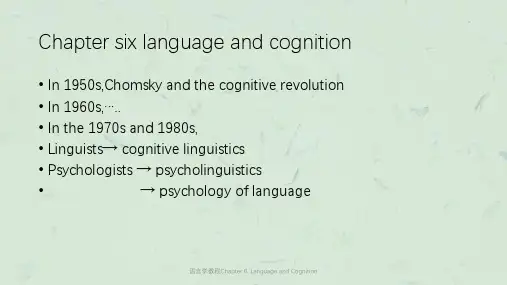
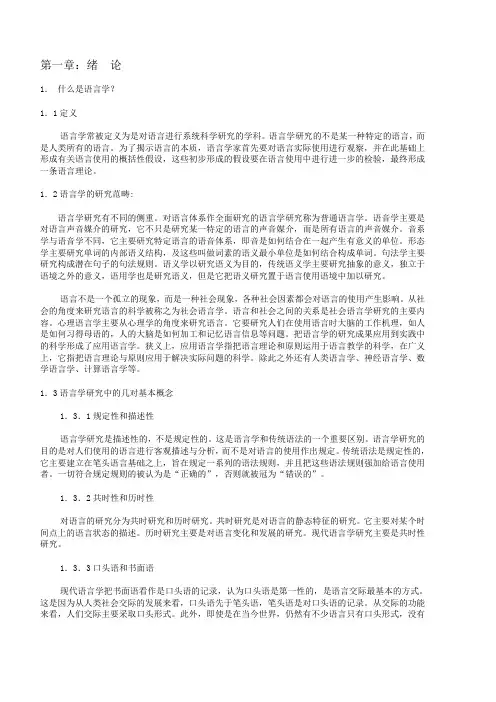
第一章:绪论1.什么是语言学?1.1定义语言学常被定义为是对语言进行系统科学研究的学科。
语言学研究的不是某一种特定的语言,而是人类所有的语言。
为了揭示语言的本质,语言学家首先要对语言实际使用进行观察,并在此基础上形成有关语言使用的概括性假设,这些初步形成的假设要在语言使用中进行进一步的检验,最终形成一条语言理论。
1.2语言学的研究范畴:语言学研究有不同的侧重。
对语言体系作全面研究的语言学研究称为普通语言学。
语音学主要是对语言声音媒介的研究,它不只是研究某一特定的语言的声音媒介,而是所有语言的声音媒介。
音系学与语音学不同,它主要研究特定语言的语音体系,即音是如何结合在一起产生有意义的单位。
形态学主要研究单词的内部语义结构,及这些叫做词素的语义最小单位是如何结合构成单词。
句法学主要研究构成潜在句子的句法规则。
语义学以研究语义为目的,传统语义学主要研究抽象的意义,独立于语境之外的意义,语用学也是研究语义,但是它把语义研究置于语言使用语境中加以研究。
语言不是一个孤立的现象,而是一种社会现象,各种社会因素都会对语言的使用产生影响。
从社会的角度来研究语言的科学被称之为社会语言学。
语言和社会之间的关系是社会语言学研究的主要内容。
心理语言学主要从心理学的角度来研究语言。
它要研究人们在使用语言时大脑的工作机理,如人是如何习得母语的,人的大脑是如何加工和记忆语言信息等问题。
把语言学的研究成果应用到实践中的科学形成了应用语言学。
狭义上,应用语言学指把语言理论和原则运用于语言教学的科学,在广义上,它指把语言理论与原则应用于解决实际问题的科学。
除此之外还有人类语言学、神经语言学、数学语言学、计算语言学等。
1.3语言学研究中的几对基本概念1.3.1规定性和描述性语言学研究是描述性的,不是规定性的。
这是语言学和传统语法的一个重要区别。
语言学研究的目的是对人们使用的语言进行客观描述与分析,而不是对语言的使用作出规定。
传统语法是规定性的,它主要建立在笔头语言基础之上,旨在规定一系列的语法规则,并且把这些语法规则强加给语言使用者。

注意:若无法显示音标,请将所附ipa-samd sild.TTF拷贝到“控制面板”的“字体”文件夹。
An Introduction to Linguistics语言学导论胡壮麟主编《语言学教程》(修订版)北京:北京大学出版社2001年Chapter 1 Invitations to Linguistics1.1Why study language?●Languages are the best mirror of the human mind. --Leibniz(莱布尼兹1646-1716)psychology mind/brain pedagogy cognitive science●The three basic questions that concern Chomsky are:(i) What constitutes knowledge of language?(ii) How is knowledge of language acquired?(iii) How is knowledge of language put to use?Leibniz, Gottfried Wilhelm(1646-1716) German rationalist philosopher, mathematician, and logician. He spent his life in the diplomatic and political service and in 1700 was appointed first president of the Academy of Sciences in Berlin. Leibniz is chiefly known as an exponent of optimism; he believed that the world is fundamentally harmonious and good, being composed of single units (monads), each of which is self-contained but acts in harmony with every other; these form an ascending hierarchy culminating in God. Their harmony is ordained by God, who never acts except for a reason that requires it, and so this world is the best of all possible worlds (a view satirized in Voltaire's Candide). Leibniz made the important distinction between necessary (logical) truths and contingent (factual) truths, and proposed a universal logical language that would eliminate ambiguity. He also devised a method of calculus independently of Newton.Chomsky, (Avram) Noam(1928-–) US theoretical linguist and political activist. His theory of transformational grammar is set out in Syntactic Structures (1957). A distinction is made between a speaker's linguistic competence, which is idealized, and actual performance; the theory sets out to account only for the former. Chomsky has revised the theory since 1957.1.2What is language?●Language is a purely human and non-instinctive method of communicating ideas,emotions and desires by means of voluntarily produced symbols. – Sapir(萨丕尔1884-1939)●Language is a system of arbitrary vocal symbols used for human communication.-- Wardhaugh(沃道)● A language is a set (finite or infinite) of sentences, each finite in length andconstructed out of a finite set of elements. – Chomsky(乔姆斯基1928 -)● A language is a system for meanings. – Halliday(韩礼德1925 -)We shall define language as “meaning potential”: that is, as sets of options, or alternatives, in meaning, that are available to the speaker-hearer. – Halliday Sapir, Edward(1884-1939) German-born US linguistics scholar and anthropologist. One of the founders of American structural linguistics, he carried out important work on American Indian languages and linguistic theory. His book Language (1921) presents his thesis that language should be studied within its social and cultural context. According to theSapir-Whorf hypothesis, in which Sapir collaborated with his pupil Benjamin Lee Whorf (1897-1941), a culture's language embodies the way in which it understands the world and dictates how those who use that language think about the world. This may be due to structural factors, such as the way time is expressed in verb tenses, as well as to more superficially obvious features such as vocabulary.1.3Design features of language●Design features Concept introduced by C. F. Hockett in the 1960s of a set of key properties of language not shared or not known to be shared, as a set, with systems of communication in any other species. Their number and names vary from one account to another; but all include, as among the most important, the properties of duality, arbitrariness, and productivity.1.3.1Arbitrariness任意性: The property of language by which there is in general nonatural (i.e. logical) relation between the form of a single lexical unit and itsmeaning. 书book livre rose motivated 理据sheep cow moo moo quackoink bedroomWhat’s in a name? that which we call a roseBy any other name would smell as sweet. – Shakespeare(莎士比亚1564-1616)名无固宜,约之以命,约定俗成谓之宜,异于约则谓之不宜。
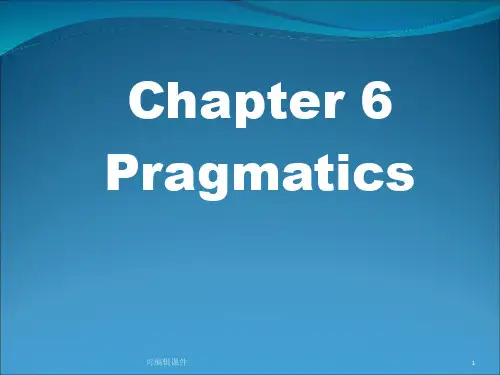
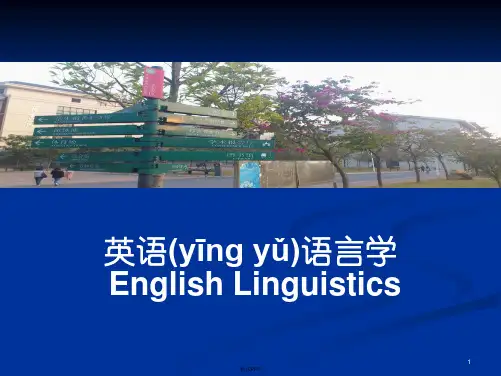
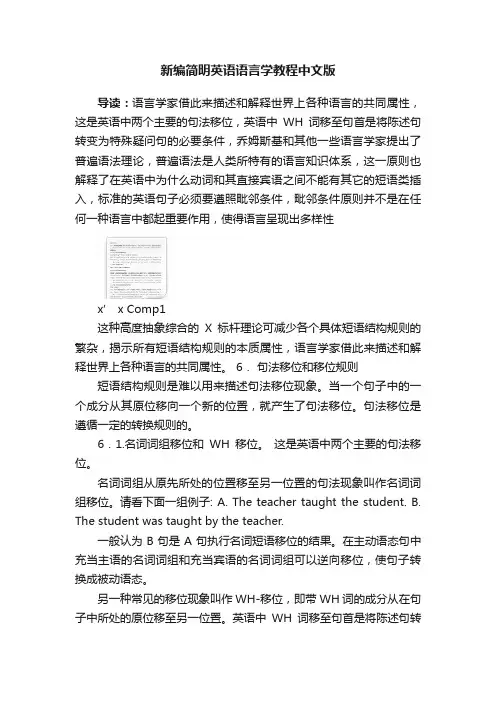
新编简明英语语言学教程中文版导读:语言学家借此来描述和解释世界上各种语言的共同属性,这是英语中两个主要的句法移位,英语中WH词移至句首是将陈述句转变为特殊疑问句的必要条件,乔姆斯基和其他一些语言学家提出了普遍语法理论,普遍语法是人类所特有的语言知识体系,这一原则也解释了在英语中为什么动词和其直接宾语之间不能有其它的短语类插入,标准的英语句子必须要遵照毗邻条件,毗邻条件原则并不是在任何一种语言中都起重要作用,使得语言呈现出多样性x’ x Comp1这种高度抽象综合的X标杆理论可减少各个具体短语结构规则的繁杂,揭示所有短语结构规则的本质属性,语言学家借此来描述和解释世界上各种语言的共同属性。
6.句法移位和移位规则短语结构规则是难以用来描述句法移位现象。
当一个句子中的一个成分从其原位移向一个新的位置,就产生了句法移位。
句法移位是遵循一定的转换规则的。
6.1.名词词组移位和WH移位。
这是英语中两个主要的句法移位。
名词词组从原先所处的位置移至另一位置的句法现象叫作名词词组移位。
请看下面一组例子: A. The teacher taught the student. B. The student was taught by the teacher.一般认为B句是A句执行名词短语移位的结果。
在主动语态句中充当主语的名词词组和充当宾语的名词词组可以逆向移位,使句子转换成被动语态。
另一种常见的移位现象叫作WH-移位,即带WH词的成分从在句子中所处的原位移至另一位置。
英语中WH词移至句首是将陈述句转变为特殊疑问句的必要条件。
例如:A. He bought the book from the bookstore yesterday.a:. What did he buy from the bookstore yesterday? b. Where did he buy the book yesterday?c. When did he buy the book from the bookstore ?以上每个疑问句的产生,都是WH词向左移出了它们的常规位置,移到句首致使句子语气发生改变。
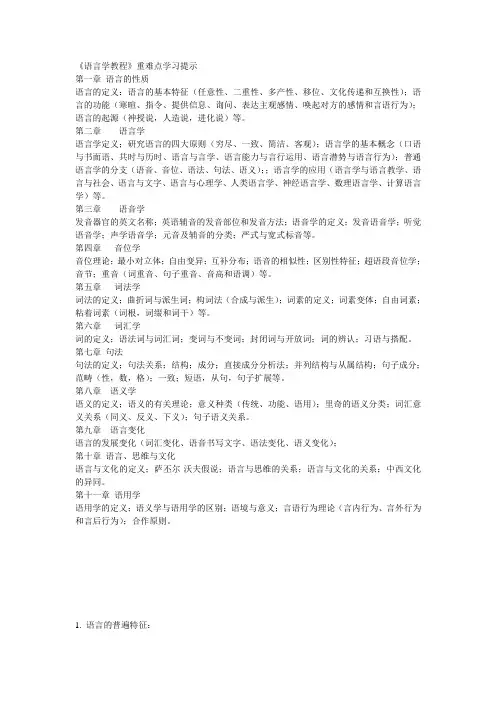
《语言学教程》重难点学习提示第一章语言的性质语言的定义:语言的基本特征(任意性、二重性、多产性、移位、文化传递和互换性);语言的功能(寒暄、指令、提供信息、询问、表达主观感情、唤起对方的感情和言语行为);语言的起源(神授说,人造说,进化说)等。
第二章语言学语言学定义;研究语言的四大原则(穷尽、一致、简洁、客观);语言学的基本概念(口语与书面语、共时与历时、语言与言学、语言能力与言行运用、语言潜势与语言行为);普通语言学的分支(语音、音位、语法、句法、语义);;语言学的应用(语言学与语言教学、语言与社会、语言与文字、语言与心理学、人类语言学、神经语言学、数理语言学、计算语言学)等。
第三章语音学发音器官的英文名称;英语辅音的发音部位和发音方法;语音学的定义;发音语音学;听觉语音学;声学语音学;元音及辅音的分类;严式与宽式标音等。
第四章音位学音位理论;最小对立体;自由变异;互补分布;语音的相似性;区别性特征;超语段音位学;音节;重音(词重音、句子重音、音高和语调)等。
第五章词法学词法的定义;曲折词与派生词;构词法(合成与派生);词素的定义;词素变体;自由词素;粘着词素(词根,词缀和词干)等。
第六章词汇学词的定义;语法词与词汇词;变词与不变词;封闭词与开放词;词的辨认;习语与搭配。
第七章句法句法的定义;句法关系;结构;成分;直接成分分析法;并列结构与从属结构;句子成分;范畴(性,数,格);一致;短语,从句,句子扩展等。
第八章语义学语义的定义;语义的有关理论;意义种类(传统、功能、语用);里奇的语义分类;词汇意义关系(同义、反义、下义);句子语义关系。
第九章语言变化语言的发展变化(词汇变化、语音书写文字、语法变化、语义变化);第十章语言、思维与文化语言与文化的定义;萨丕尔-沃夫假说;语言与思维的关系;语言与文化的关系;中西文化的异同。
第十一章语用学语用学的定义;语义学与语用学的区别;语境与意义;言语行为理论(言内行为、言外行为和言后行为);合作原则。

语言学教程胡壮麟语言学教程 - 了解语言,理解沟通之道引言语言是人类交流和沟通的工具,是我们进行思维和表达的媒介。
语言学是研究语言的科学,涵盖语音学、语法学、语义学、语用学等多个领域。
本教程将向您介绍语言学的基本概念和核心内容,帮助您更好地理解语言的本质和沟通的方式。
一、语音学语音学是研究语言声音的学科。
它主要关注语音的产生、发音和听觉特征。
在语音学中,语音被分为音素和音素组合。
音素是语言中的最小语音单位,如英语中的/d/和/t/;而音素组合则是由不同音素组成的词语。
通过学习语音学,我们可以更好地理解不同语言之间的发音差异,并学会正确发音。
二、语法学语法学是研究语言结构的学科。
它涉及词法、句法和语义等方面。
词法研究单词的形态和构词规则,句法研究句子的结构和语序,语义研究单词和句子的意义。
通过学习语法学,我们能够了解不同语言的句法规则,掌握正确的语序和句子构造方式。
三、语义学语义学是研究语言意义的学科。
它探讨语言符号与所指对象之间的关系。
语义学关注词义和句义,帮助我们理解单词和句子的意义,以及它们在不同语境中的使用方式。
通过学习语义学,我们可以避免歧义和误解,准确表达自己的观点。
四、语用学语用学是研究语言使用情境和交际行为的学科。
它研究语言的言外之意、语篇结构和交际目的。
语用学帮助我们理解语言交流中的隐含信息、非字面意义和言外之意。
通过学习语用学,我们可以更好地理解他人的意图和态度,提高沟通的效果。
五、语言变异语言变异是指语言在不同地区、社会和个体之间的差异。
这种差异可以体现在发音、词汇、语法和语义等方面。
了解语言变异可以帮助我们更好地适应不同的语言环境,避免交流障碍。
六、语言习得与教学语言习得是指人类通过日常交流和接触学会一种语言的过程。
语言教学是帮助人们学习第二语言或外语的教育活动。
通过了解语言习得和教学的原理,我们可以更有效地学习和教授语言,提高语言水平。
结语语言是人类文明的基石,也是人类社交和思考的重要工具。
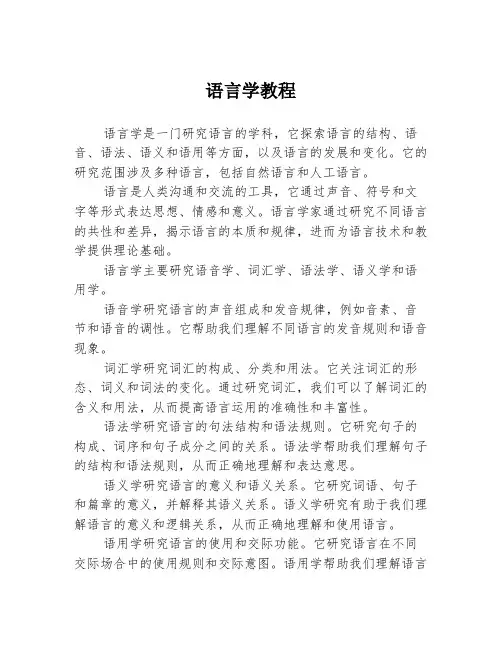
语言学教程语言学是一门研究语言的学科,它探索语言的结构、语音、语法、语义和语用等方面,以及语言的发展和变化。
它的研究范围涉及多种语言,包括自然语言和人工语言。
语言是人类沟通和交流的工具,它通过声音、符号和文字等形式表达思想、情感和意义。
语言学家通过研究不同语言的共性和差异,揭示语言的本质和规律,进而为语言技术和教学提供理论基础。
语言学主要研究语音学、词汇学、语法学、语义学和语用学。
语音学研究语言的声音组成和发音规律,例如音素、音节和语音的调性。
它帮助我们理解不同语言的发音规则和语音现象。
词汇学研究词汇的构成、分类和用法。
它关注词汇的形态、词义和词法的变化。
通过研究词汇,我们可以了解词汇的含义和用法,从而提高语言运用的准确性和丰富性。
语法学研究语言的句法结构和语法规则。
它研究句子的构成、词序和句子成分之间的关系。
语法学帮助我们理解句子的结构和语法规则,从而正确地理解和表达意思。
语义学研究语言的意义和语义关系。
它研究词语、句子和篇章的意义,并解释其语义关系。
语义学研究有助于我们理解语言的意义和逻辑关系,从而正确地理解和使用语言。
语用学研究语言的使用和交际功能。
它研究语言在不同交际场合中的使用规则和交际意图。
语用学帮助我们理解语言交际的目的和方式,从而更好地进行沟通和交流。
除了以上主要学科,语言学还涉及历史语言学、社会语言学、心理语言学和比较语言学等子领域。
这些领域研究语言的历史发展、社会变化、认知过程和语言间的关系。
总之,语言学是一门综合性的学科,它帮助我们了解语言的本质和规律,以及语言的发展和变化。
通过学习语言学,我们可以更好地理解和应用语言,提高沟通和交流的能力。
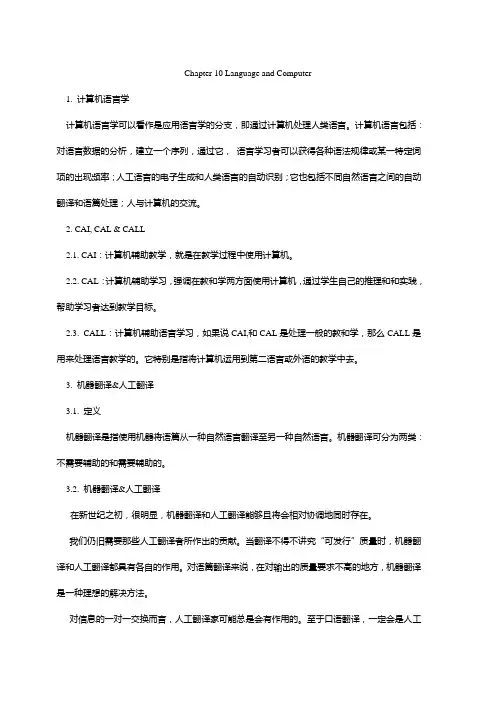
Chapter 10 Language and Computer1. 计算机语言学计算机语言学可以看作是应用语言学的分支,即通过计算机处理人类语言。
计算机语言包括:对语言数据的分析,建立一个序列,通过它,语言学习者可以获得各种语法规律或某一特定词项的出现频率;人工语言的电子生成和人类语言的自动识别;它也包括不同自然语言之间的自动翻译和语篇处理;人与计算机的交流。
2. CAI, CAL & CALL2.1. CAI:计算机辅助教学,就是在教学过程中使用计算机。
2.2. CAL:计算机辅助学习,强调在教和学两方面使用计算机,通过学生自己的推理和和实践,帮助学习者达到教学目标。
2.3. CALL:计算机辅助语言学习,如果说CAI,和CAL是处理一般的教和学,那么CALL是用来处理语言教学的。
它特别是指将计算机运用到第二语言或外语的教学中去。
3. 机器翻译&人工翻译3.1. 定义机器翻译是指使用机器将语篇从一种自然语言翻译至另一种自然语言。
机器翻译可分为两类:不需要辅助的和需要辅助的。
3.2. 机器翻译&人工翻译在新世纪之初,很明显,机器翻译和人工翻译能够且将会相对协调地同时存在。
我们仍旧需要那些人工翻译者所作出的贡献。
当翻译不得不讲究“可发行”质量时,机器翻译和人工翻译都具有各自的作用。
对语篇翻译来说,在对输出的质量要求不高的地方,机器翻译是一种理想的解决方法。
对信息的一对一交换而言,人工翻译家可能总是会有作用的。
至于口语翻译,一定会是人工翻译者的市场。
4. 计算机语料库4.1. 语料库(corpus)A collection of linguistic data, either compiled as written texts or as a transcription of recorded speech. The main purpose of a corpus is to verify a hypothesis about language--- for example, to determine how the application of a particular sound, word, or syntactic construction varies.语料库是一个语言数据的集合,可以有书面文本构成,也可以由录音言语的转写本构成。
《语言学教程》重难点学习提示第一章语言的性质语言的定义:语言的基本特征(任意性、二重性、多产性、移位、文化传递和互换性);语言的功能(寒暄、指令、提供信息、询问、表达主观感情、唤起对方的感情和言语行为);语言的起源(神授说,人造说,进化说)等。
第二章语言学语言学定义;研究语言的四大原则(穷尽、一致、简洁、客观);语言学的基本概念(口语与书面语、共时与历时、语言与言学、语言能力与言行运用、语言潜势与语言行为);普通语言学的分支(语音、音位、语法、句法、语义);;语言学的应用(语言学与语言教学、语言与社会、语言与文字、语言与心理学、人类语言学、神经语言学、数理语言学、计算语言学)等。
第三章语音学发音器官的英文名称;英语辅音的发音部位和发音方法;语音学的定义;发音语音学;听觉语音学;声学语音学;元音及辅音的分类;严式与宽式标音等。
第四章音位学音位理论;最小对立体;自由变异;互补分布;语音的相似性;区别性特征;超语段音位学;音节;重音(词重音、句子重音、音高和语调)等。
第五章词法学词法的定义;曲折词与派生词;构词法(合成与派生);词素的定义;词素变体;自由词素;粘着词素(词根,词缀和词干)等。
第六章词汇学词的定义;语法词与词汇词;变词与不变词;封闭词与开放词;词的辨认;习语与搭配。
第七章句法句法的定义;句法关系;结构;成分;直接成分分析法;并列结构与从属结构;句子成分;范畴(性,数,格);一致;短语,从句,句子扩展等。
第八章语义学语义的定义;语义的有关理论;意义种类(传统、功能、语用);里奇的语义分类;词汇意义关系(同义、反义、下义);句子语义关系。
第九章语言变化语言的发展变化(词汇变化、语音书写文字、语法变化、语义变化);第十章语言、思维与文化语言与文化的定义;萨丕尔-沃夫假说;语言与思维的关系;语言与文化的关系;中西文化的异同。
第十一章语用学语用学的定义;语义学与语用学的区别;语境与意义;言语行为理论(言内行为、言外行为和言后行为);合作原则。
语言学教程文档目录1. 语言学概述 (2)1.1 语言学定义与研究对象 (2)1.2 语言学分支及分类 (4)1.3 语言学在社会科学中的地位 (5)2. 语言学的理论基础 (6)2.1 语音学理论 (8)2.2 语法学理论 (9)2.3 语义学理论 (10)2.4 语用学理论 (12)3. 语言的结构与功能 (13)3.1 语言的结构分析 (15)3.1.1 音系与音节结构 (16)3.1.2 语法结构与句型分析 (17)3.1.3 语义场与语义关系 (18)3.2 语言的功能与运用 (20)3.2.1 语言的交际功能 (22)3.2.2 语言的表达功能 (23)3.2.3 语言的指示功能 (24)4. 语言的发展与社会变迁 (26)4.1 语言发展的规律与特点 (27)4.2 语言与社会的相互关系 (28)4.3 语言的地域差异与方言现象 (30)4.4 语言的接触与融合现象 (31)5. 语言学的应用与实践 (33)5.1 语言与文学的关系 (34)5.2 语言与翻译的实践 (35)5.3 语言与人工智能的发展 (37)5.4 语言学在其他领域的应用 (39)6. 语言学的研究方法与路径 (40)6.1 语言学的研究方法概述 (42)6.2 田野调查与实证研究 (43)6.3 文献资料的搜集与分析 (45)6.4 实验方法与语言学研究实践 (46)7. 结论与展望 (47)7.1 对语言学研究的总结与反思 (48)7.2 未来语言学发展的趋势与展望 (49)1. 语言学概述语言学作为一门研究人类语言的科学,具有悠久的历史和丰富的研究领域。
它主要探讨语言的本质、结构、功能以及语言与社会、文化、心理等方面的关系。
语言学可以分为几个子领域,包括语音学、音系学、形态学、句法学、语义学、语用学等。
语音学关注声音的产生、传播和感知,研究语音的物理属性和生理机制。
音系学则研究音素和音系的分布规律,揭示语音在各种语言中的变化和差异。
语言学教程语言学教程语言学是研究语言的科学,它关注的是语言的结构、使用和演变。
在本教程中,我们将介绍语言学的基本概念和主要研究领域,帮助读者了解语言学的基本原理和方法。
一、什么是语言学?语言学是研究语言的学科,它探究语言的本质、结构和使用。
语言是人类交流和表达思想的工具,它通过声音、符号和规则来构建意义。
语言学家研究语言的各个方面,包括语音学、语法学、语义学、语用学和历史比较语言学等。
二、语音学语音学是语言学的一个重要分支,研究语音的产生、传播和感知。
它涉及到语音的音素(语言中的基本音单位)和音位(音素在特定语言中的表现形式)。
语音学家使用声谱图、语音学家和实验方法来研究语音的特征和变化规律。
三、语法学语法学是研究语言的结构和组织的学科。
它研究语言的句子结构、词法和句法规则。
语法学家分析和描述语言中的句子成分和句法关系,并研究语言中的语法现象和规律。
四、语义学语义学是研究意义的学科。
它关注语言中的词汇和句子的意义。
语义学家研究词汇的意义和词义关系,分析句子的逻辑关系和语义关系。
通过语义学的研究,我们可以更好地理解语言中的意义和信息传递。
五、语用学语用学是研究语言使用的学科,它关注语言在特定情境下的使用和理解。
语用学家研究语言中的说话人意图、语体、修辞和隐喻等现象,研究语言在社交交流中的作用和效果。
六、历史比较语言学历史比较语言学是研究语言演变和语系关系的学科。
它比较不同语言间的相似性和差异性,通过语音、词汇和语法的比较,揭示语言的历史发展和变迁。
七、应用语言学应用语言学是语言学的一个重要分支,它将语言学理论和方法应用于实际问题的解决中。
应用语言学研究语言的教学、语言规划、翻译和语言治疗等领域,为语言相关的应用提供理论依据和实践指导。
结语语言学研究语言的各个方面,帮助我们更好地理解语言的本质和特点。
通过学习语言学,我们可以更好地掌握和应用语言,促进跨文化交流和理解。
以上就是本教程对语言学基本概念和主要研究领域的介绍。
1. Semantics(语义学)Semantics is the study of meaning of the linguistic units, words and sentences in particular. (语义学是对语言单位,尤其是词和句子的意义的研究。
)2. Meanings of “meaning”1). Meaning:Meaning refers to what a language expresses about the world we live in or any possible or imaginary world.(意义是指语言所表达的关于现实世界或者想象中的世界的想法。
)2). Connotation: (内涵)Connotation means the properties of the entity a word denotes.(内涵指的是一个词所指称的实体的特征。
)3). Denotation: (外延)Denotation involves the relationship between a linguistic unit and the non-linguistic entity to which it refers. Thus it is equivalent to referential meaning. (外延涉及语言单位与非语言实体之间的关系。
在这个意义上,它跟指称意义是一样的。
)3. The difference between meaning, concept, connotation, and denotationMeaning refers to the association of language symbols with the real world. There are many types of meaning according to different approaches.Concept is the impression of objects in people’s mind.Connotation is the implied meaning, similar to implication.Denotation, like sense, is not directly related with objects, but makes the abstract assumption of the real world.4. The referential theory1). DefinitionThe theory of meaning which relates the meaning of a word to the thing it refers to, or stands for, is known as the referential theory.(把词语意义跟它所指称或代表的事物联系起来的理论,叫做指称理论)2). The semantic triangle (语义三角)Ogden and Richards presented the classic “Semantic Triangle” as manifested in the following diagram。
语言学教程
语言学教程是一门涉及语言的科学研究。
它研究语言的结构、用途和演化。
在语言学教程中,我们将学习各种语言学的重要概念和理论。
这些概念包括语音学、语法学、语义学和语用学。
通过学习语言学,我们可以更好地理解人类语言的本质和功能。
首先,让我们来了解语音学。
语音学研究语音的产生、传播和感知。
它研究语音的音素、音节和音素组合。
在语音学中,我们将学习如何描述和分类语音,以及不同语音之间的相似和差异。
接下来,是语法学。
语法学研究语言的结构和规则。
它研究词汇、句法和句子结构。
在语法学中,我们将学习如何分析句子的结构,并理解不同语言中的语法规则。
然后,是语义学。
语义学研究语言的意义和符号。
它研究单词和句子的意义以及语言中的逻辑和推理。
在语义学中,我们将学习如何分析和解释语言的意义,以及语言中的含义和推理。
最后,是语用学。
语用学研究语言在特定上下文中的使用和交流。
它研究言语行为、会话结构和语言交际。
在语用学中,我们将学习如何根据特定情境和目的选择适当的语言形式,以及如何理解和解释他人的意图和信息。
通过学习这些语言学的概念和理论,我们可以更好地理解语言的本质和功能。
无论是学习一门新的语言,还是研究语言的结
构和演化,语言学都为我们提供了强大的工具和框架。
让我们一起探索语言学的世界吧!。